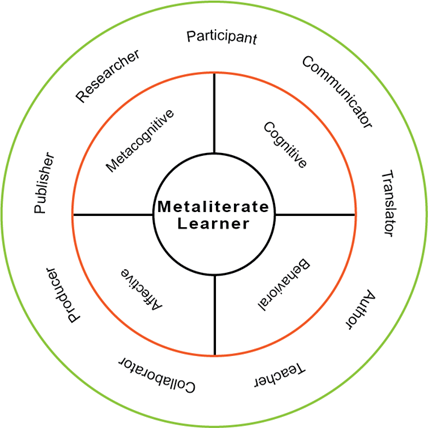The Metaliterate Learner Figure
The metaliterate learner figure shows that metaliteracy places an emphasis on the whole person, how we learn, what we understand, how we are constantly changing through learning activities, how we translate our learning into action, and how we reflect on our own learning as a continuous process. This circular image shows the metaliterate learner at the center of four inter-related domains of learning (metacognitive, cognitive, affective and behavioral), and expands out to include a variety of active roles (participant, communicator, translator, author, teacher, etc.). As metaliterate learners we take on these roles as we discover, consume, evaluate, produce, and share information using a range of changing technologies.

The Outer Ring
Closely examine this visual representation of the metaliterate learner and think about the active roles you have played that are shown in the outer ring of this image.
Consider your roles in both academic and everyday life settings.
- Think about the ways you have been a participant, communicator, or translator of information.
- Reflect on the times you have participated with others to discuss, create or share information.
- Consider how you have communicated ideas or translated information from one language to another or to reach a different audience.
- Recall the opportunities you have had as an author of documents in any format (text, image, sound, or multimedia) and how this work was shared with others.
- Remember the ways you have taught friends, family, peers, or colleagues how to do something.
- Consider how much collaboration you have been involved in and to what extent you have been a part of a team to achieve goals.
- Think about the information you may have produced and published for a specific or general audience.
- Reflect on your role as a researcher to expand your own knowledge, to learn something new, solve a problem, voice an opinion, or to earn a grade in a course or a certificate in a MOOC.
The Central Rings
Now, review the metaliterate learner figure again and take a close look at the two central rings, with the metaliterate learner at the center, surrounded by four domains of learning: metacognitive, cognitive, behavioral, and affective. Generally, the metacognitive domain refers to how we think about our own thinking, and how we reflect on how and what we learn. The cognitive domain refers to our comprehension or what we learn after completing an activity. The behavioral domain relates to what we are able to do after a particular learning activity, specifically the skills and competencies we develop as a result or outcome. The affective domain refers to how we feel after a particular learning activity, with an emphasis on our emotions and attitudes.
You can read more about these four domains on the Metaliteracy Website.
(http://metaliteracy.org/learning-objectives/)
This work by Metaliteracy Learning Collaborative is licensed under a Creative Commons Attribution-NonCommercial 4.0 International License.